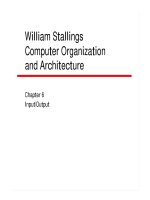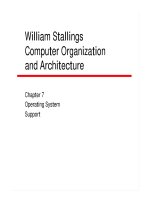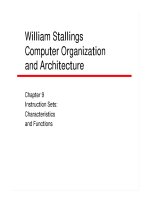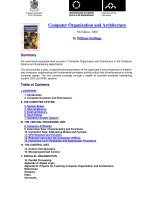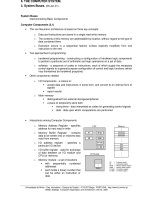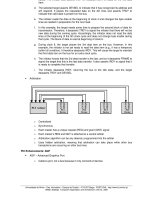Computer Organization and Architecture - Chapter 1: Introduction pot
Bạn đang xem bản rút gọn của tài liệu. Xem và tải ngay bản đầy đủ của tài liệu tại đây (183.93 KB, 39 trang )
William Stallings
Computer Organization
and Architecture
7
th
Edition
Chapter 1
Introduction
Architecture & Organization 1
•
Architecture is those attributes visible to
the programmer
—
Instruction set, number of bits used for data
representation, I/O mechanisms, addressing
techniques.
—
e.g. Is there a multiply instruction?
•
Organization is how features are
implemented
—
Control signals, interfaces, memory technology.
—
e.g. Is there a hardware multiply unit or is it done by
repeated addition?
Architecture & Organization 2
•
All Intel x86 family share the same basic
architecture
•
The IBM System/370 family share the
same basic architecture
•
This gives code compatibility
—
At least backwards
•
Organization differs between different
versions
Differences in organization but not architecture
leads to “families”
•
Different cost and performance
•
Run same code
•
Families may span years of technological
advancement
Hierarchical Nature of Complex Systems
•
Each level of system hierarchy consists of
set of components and their
interrelationships
—
Operation of components Function
—
Interrelation of components Structure
•
Each successively higher layer describes
simplified/more abstract view of lower
levels
Hierarchical Nature of Complex Systems
(continued)
•
Breaking system into components or modules
forces designer to develop a detailed
understanding of the data that is passed between
them
•
Working within the hierarchy, a designer needs
to only concern him/herself with the details of his
or her module at that specific level
•
Working with a well-defined set of inputs,
outputs, and function definition, designers can
completely design their module without any
knowledge of how rest of system is made
Modular System Design
Applying a modular methodology to system
design results in:
—
a more manageable project
—
quicker design time by allowing multiple
people with differing expertise to participate
(although up-front investment of time feels
like a drawback)
—
a higher quality system
—
a more maintainable system
—
increased module reusability
Modular System Design (continued)
There are two methods to use
toward a designing a modular
system:
—
Top down
—
Bottom up
Top Down System Design
•
Solving a problem by dividing the system
into individual functions and building a
component to satisfy each function.
•
Benefits of Top Down Design
—
Efficient use of components
—
Easier to meet performance goals of the system
specification
•
Drawbacks of Top Down Design
—
More expensive and time consuming
Bottom Up System Design
•
Solving a problem using an existing
system (e.g., using DLL's to create a new
application)
•
Cheaper in small quantities
•
Design time is reduced
•
Past experiences can be drawn upon
Concept of Black Boxes
•
This is the building block of the
hierarchical system design.
•
If inputs, outputs, and functions are well
defined, the designer doesn't need to
know about anything above or below in
the system
Implementation of components
There are three basic ways to
implement a system component
—
Hardware (HW)
—
Software (SW)
—
Firmware (FW)
Hardware
•
The permanent, physical
implementation of circuits and
devices
•
Hardware is required for all systems
Software
•
The programs contained in
read/write memory ranging from
machine language to high-level
languages
•
Requires a processor to run
(hardware dependent)
Firmware
•
Lies between hardware and software
•
Programs (usually machine code)
contained in read only memory
Performance Characteristics
•
Throughput/speed – HW best; FW average;
SW worst
•
Development Cost – HW best; FW average;
SW worst
•
Adaptability – HW worst; FW average;
SW best
•
Reliability – HW best; FW average;
SW average
Structure & Function
•
Structure is the way in which components
relate to each other
•
Function is the operation of individual
components as part of the structure
Function
•
All computer functions are:
—
Data processing
—
Data storage
—
Data movement
—
Control
Data Processing
—
The basic function of any computer is to process data
—
Describes arithmetic and logical operations performed
on data
—
Although end result may be complex, there are few
distinct types of data processing
Data Storage
•
Long term
—
Logging
—
Data records
•
Short term
—
temp variables – e.g., buffer containing the last key
pressed
—
program control data – e.g., loop variables
Data Movement
•
Computer must be able to communicate
with outside world
•
Data must be “accessible” to devices
outside computer
•
Two types:
—
Peripheral
—
Data communications
Data movement to a peripheral
•
Data must be passed between computer
and I/O devices connected to computer
•
Typically to simple devices
•
Examples
—
monitors and keyboards
—
data acquisition
—
peripheral control
Data Movement to remote devices (data
communications)
•
Data communications is data movement
over a longer range
•
Typically to smart devices or other
computers
Control
•
Something needs to monitor operation
and maintain control of data processing,
data storage, and data movement.
•
Automated control of computer’s
resources
Functional View
